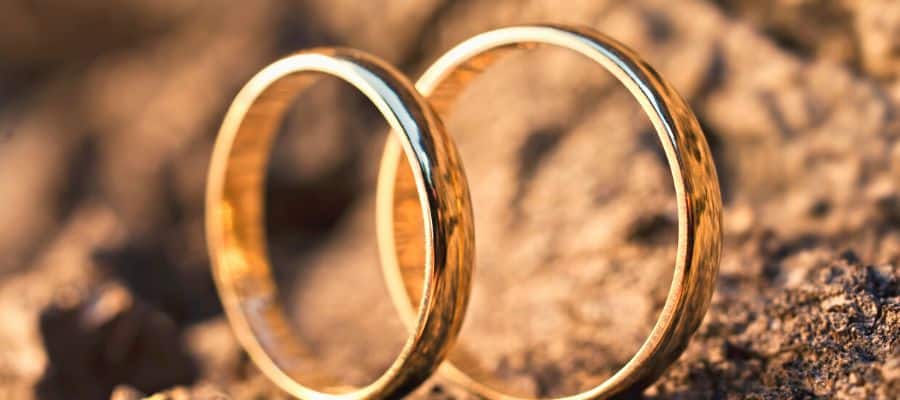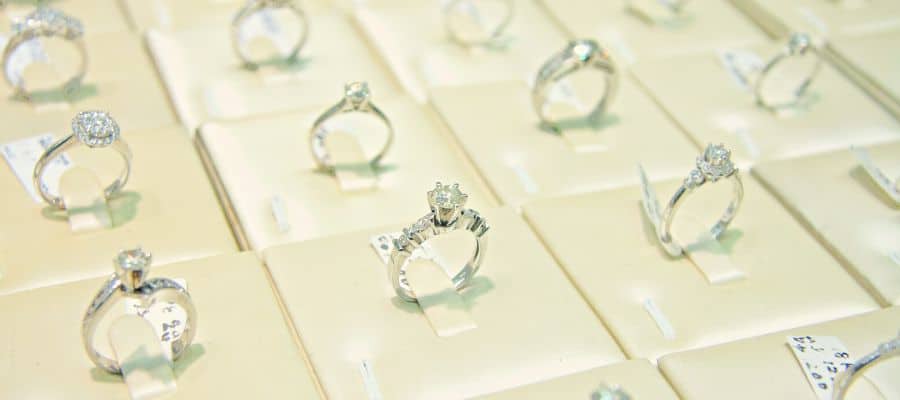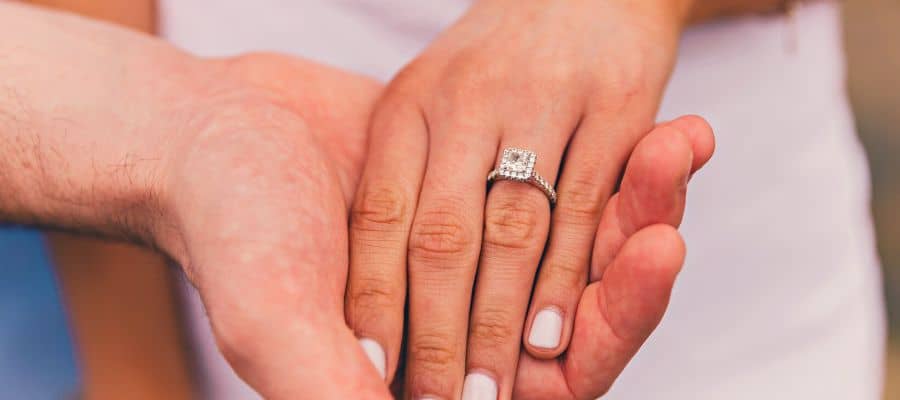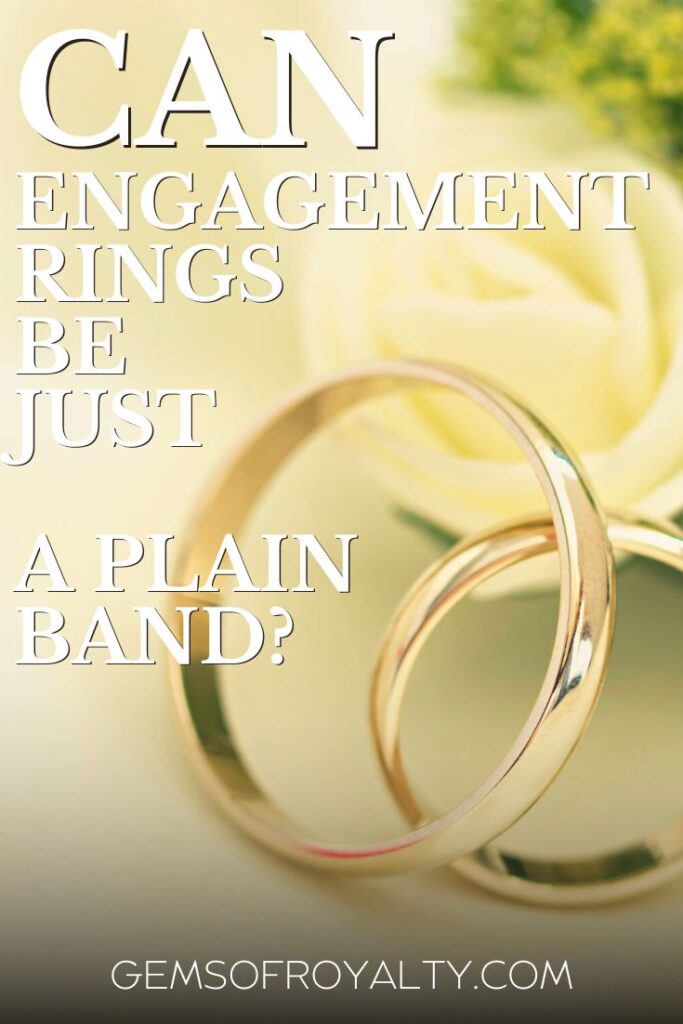Gone are the days when an engagement ring had to feature a sparkling diamond to signify a couple’s commitment to one another. Instead, the trend of simple, understated plain band engagement rings is on the rise. But is it appropriate?
Plain bands can be used as engagement rings. In recent years, plain band rings have become increasingly popular as couples prefer simple, understated designs. The plain band can be made from gold, silver, or platinum and adorned with engravings.
In this guide, I’ll explain some of the “traditional” etiquette around engagement rings and some exciting alternatives that might interest you. We’ll even cover some budget options that won’t disappoint. With this in mind, let’s get started.
Do Engagement Rings Need Settings and Stones?

Engagement rings are a unique symbol of love and commitment, but do they need settings and stones to be meaningful?
Some people may argue that the value of an engagement ring lies in its diamonds or other precious stones. After all, these sparkling gems were coveted for centuries and seen as signs of luxury and wealth. But is this really what makes an engagement ring special?
In my opinion, the value of an engagement ring comes from the sentiment behind it.
It’s the thought and care that goes into choosing the perfect ring for your loved one and the promise it represents for your future together. So whether the ring has a setting and stones or not, it can still hold a deep and personal meaning for the couple.
Furthermore, not everyone can afford a diamond engagement ring. Some may even have ethical concerns about the diamond industry as a whole. In these cases, an engagement ring without a setting or stone can still be a beautiful and thoughtful option.
In the end, it’s important to remember that the value of an engagement ring lies in the love and commitment it symbolizes. Whether it has a setting and stones or not, the most important thing is the promise it represents.
Traditional Engagement Ring Design Etiquette

The traditional engagement ring is steeped in history and etiquette.
In days gone by, the ring was seen as a symbol of ownership, with the man giving a ring to his betrothed as a way of claiming her as his property. But today, the engagement ring has become a beautiful symbol of love and partnership.
You should consider a few things when choosing an engagement ring.
Traditionally, the most important element is the diamond itself, the ring’s centerpiece. Diamonds are known for their beauty, rarity, and durability, making them the perfect symbol of the strength and endurance of a relationship.
When it comes to the band, they’re traditionally made of gold or platinum and feature a single diamond as the centerpiece. The diamond is typically cut in a round or princess shape and is set in a simple band with a few accent diamonds or other precious stones.
One of the key features of a traditional engagement ring design is the setting of the diamond.
The classic “solitaire” setting is the most popular, showcasing the diamond in its sparkling glory. The diamond is held in place in this setting by a series of prongs. This design allows light to pass through the diamond and create a dazzling display of sparkle.
Another popular setting is the “pave” setting, which is similar to the solitaire setting, but with the addition of small diamonds or other precious stones set into the ring’s band. This style creates a stunning and sophisticated look that’s perfect for those who want a little extra sparkle.
But regardless of your favorite setting choice, it’s important to remember that the engagement ring symbolizes your love and commitment. So it should reflect your personal style and taste and be chosen with care and consideration.
Whether you opt for a traditional solitaire setting or a more modern, pave setting, choose a ring that truly represents your love for your partner.
Choosing a Plain Band Engagement Ring: Pros and Cons

Plain band engagement rings are simple and elegant, offering a sleek and modern look that’s perfect for those who prefer a more understated style. But before you commit to a plain band ring, it’s essential to consider the pros and cons.
Let’s take a look:
Pros
- Simplicity. One of the biggest pros of a plain band engagement ring is its simplicity. These rings are elegant and timeless, offering a clean and classic look that never goes out of style. They’re also versatile and can be paired with any type of diamond or other precious stone, allowing you to create a truly unique look.
- Affordability. Another pro of a plain band engagement ring is its affordability. Because these rings don’t have a lot of intricate details or diamonds, they tend to be less expensive than more ornate designs. This aspect can be a significant advantage for those on a tight budget or who want to save money for other expenses, like the wedding itself!
- Durability. A plain band engagement ring can be more durable than other designs because it has fewer intricate details and diamonds that can break or fall out. What’s more, the durability factor can be an advantage for those who are active or have jobs that require manual labor, as it reduces the risk of damaging the ring.
Cons
- No sparkle. One of the biggest cons is the lack of sparkle. Because these rings don’t have diamonds or other precious stones, they don’t have the same level of sparkle and shine as more ornate designs. But having no sparkle can be a significant downside for those who love a little bling or want their engagement ring to make a big statement.
- Lack of personality. Another con of a plain band engagement ring is that it can lack personality. These rings are simple and understated, meaning they may not reflect the individual style or character of the person wearing them. This sense of “dullness” can be a problem for those who want their engagement ring to be unique and special.
- Limited design options. Another con of a plain band engagement ring is that it may have limited design options compared to other engagement ring styles. These rings are simple and understated, and they don’t have a lot of room for customization or variation. If you want a one-of-a-kind ring or to express your style through your engagement ring, this may be a dealbreaker.
Non-Traditional Engagement Rings Options

More and more couples are choosing non-traditional options that reflect their unique styles and personalities.
One popular option is a colored gemstone engagement ring. Instead of a diamond, the center stone can be a vibrant sapphire, emerald, or ruby. These colorful gems can add a pop of personality to the ring and make it one-of-a-kind.
Another trend is to mix and match different gemstones in a single ring. For instance, a ring with a diamond center stone surrounded by sapphires or emeralds. In this way, you will create a look that’s both beautiful and unique.
Some couples are also opting for alternative materials for their engagement rings. Rose gold, for instance, has become increasingly popular in recent years. This warm and romantic metal adds a touch of vintage elegance to any ring.
Other options include white gold, yellow gold, and even platinum.
Of course, not everyone wants a flashy, attention-grabbing ring. For these couples, a minimalist engagement ring might be a perfect choice. Simple, understated designs with clean lines and a single diamond or gemstone can be just as beautiful as a more elaborate ring.
Don’t be afraid to think outside the box and choose a ring that reflects who you are as a couple.
Budget-Friendly Engagement Ring Styles

If you’re on a tight budget but still want to pop the question in style, don’t worry – plenty of beautiful and budget-friendly engagement ring options are out there.
- First, consider choosing a smaller center stone. A diamond doesn’t have to be huge to be beautiful – in fact, many people prefer dainty, delicate rings that are easy to wear daily. Plus, a smaller stone will cost less without sacrificing sparkle.
- Another option is to choose a gemstone instead of a diamond. Colored gems like sapphires, emeralds, and rubies are often more affordable than diamonds and come in a stunning array of colors. A colored gemstone can add a unique and personal touch to your engagement ring.
- Consider choosing a lower clarity grade if you’re set on a diamond. While a flawless diamond may be beautiful, most people can’t tell the difference between a slightly included diamond and a flawless one. Choosing a lower clarity grade can save you hundreds or even thousands of dollars without sacrificing the sparkle of your ring.
- Finally, don’t be afraid to shop around. Different jewelers and retailers may offer different prices for the same ring, so it’s worth comparing prices and finding the best deal.
Common Misconceptions About Engagement Rings

It’s a common misconception that engagement rings have to be diamonds. While diamonds are certainly a popular choice, they’re by no means the only option. Many couples opt for alternative gemstones like sapphires, emeralds, or even more unique options like moissanite.
Another misconception is that engagement rings have to be expensive. While it’s true that some rings can be pretty costly, no rule says your engagement ring has to break the bank. It’s ultimately about the sentiment behind the ring and the commitment it represents, not the price tag.
Another common misconception is that engagement rings have to be flashy and ostentatious. This isn’t the case. It’s all about personal preference.
It’s also a widely held belief that engagement rings must be worn on the left hand. While this is the traditional choice, no hard and fast rule says you must follow tradition. Some people wear their engagement ring on the right hand or even on a different finger altogether.
In short, there are many misconceptions about engagement rings, but the most important thing to bear in mind is the love and commitment between two people. Whether it’s a diamond, another gemstone, expensive or affordable, flashy or understated, the crucial thing is that it holds special meaning for the couple.
Choosing the Perfect Engagement Ring for Your Partner

Choosing the perfect engagement ring for your partner can be a daunting task. After all, this is a piece of jewelry that they’ll be wearing for the rest of their life, and you want to make sure it’s something they’ll love and cherish.
So how can you make sure you get it right? Here are a few pointers:
- Consider your partner’s style. Do they prefer dainty and delicate pieces or something bold and eye-catching? Take these preferences into account when choosing a ring.
- Consider the metal. Gold, platinum, and white gold are all popular choices, but each has unique characteristics and may appeal to your partner more or less. Think about your partner’s skin tone and overall aesthetic when making this decision.
- Consider the setting. Do you want a solitaire, where the gemstone is the center of attention, or a halo setting, where smaller diamonds surround the main gemstone? Again, this decision should be based on your partner’s personal style and preferences.
Ultimately, the perfect engagement ring is the one your partner loves and feels comfortable wearing. Be bold and ask for their input, or to do some subtle (or not-so-subtle) investigating to figure out what they might like.
Final Thoughts
When it comes to choosing the perfect engagement ring, it’s essential to keep your partner’s style and preferences in mind. While diamonds are a classic choice, many other beautiful and unique gemstones are worth considering.
Think about the type of metal and setting that best suits your partner’s aesthetic, and don’t be afraid to think outside the box.
The most crucial factor is that the ring symbolizes your love and commitment to each other. So choose a ring that reflects the special connection between you and your partner – one that they’ll love and cherish for the rest of their life!
If you found this article useful, make sure you save this pin below to your Jewelry board.


